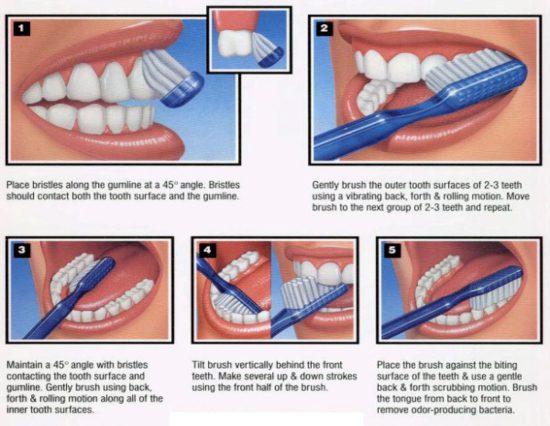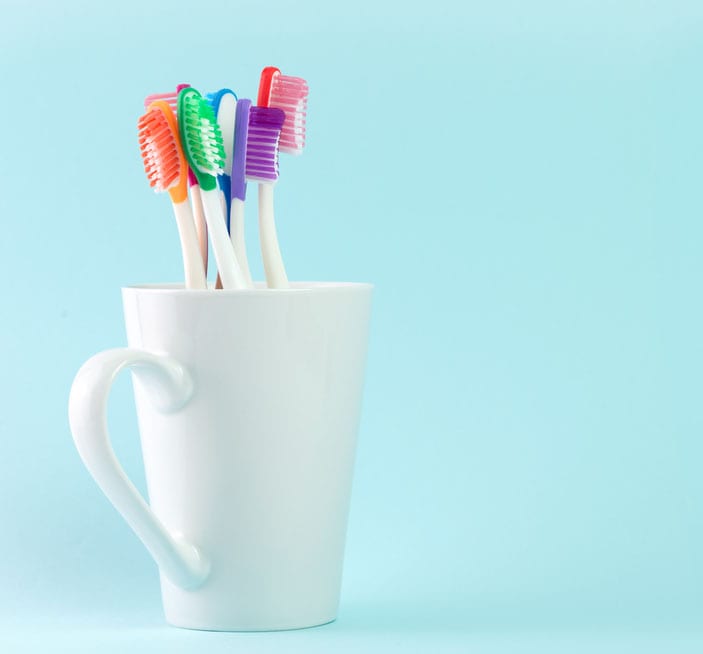Oral Hygiene in Los Angeles
To keep your teeth and mouth healthy, you must remove bacterial plaque and tartar build-up from your teeth, mouth, and gums with proper brushing and flossing techniques. Regular cleanings by your dentist are also important to maintain good oral health.
Daily dental preventive care can keep your mouth healthy and avoid bad breath, mouth fissures, bacterial plaque, tartar build-up, tooth decay, and tooth loss. Daily cleaning will help minimize calculus (hardened plaque) formation, but it cannot completely prevent it. Professional deep cleanings by your dentist are necessary to remove calculus from places your toothbrush and floss may miss.
What Can You Do to Maintain Good Oral Health?
Proper Teeth Brushing Technique
Oral hygiene at home begins with the right equipment. Your home care routine is essential to a healthy mouth, so we created a comprehensive list of dental hygiene tips below.

Choose a soft-bristled toothbrush that allows you to reach every surface of your teeth. If the bristles on your toothbrush are bent or frayed, replace it, as worn-out toothbrush will not clean your teeth properly.
To clean the outside surfaces of your teeth, position the brush at a 45-degree angle where the gums and teeth meet. Gently move the brush in a circular motion using light pressure (but not so much that you feel discomfort). Follow the same directions while cleaning the inside of the back teeth.
To clean the inside chewing surfaces of the upper and lower front teeth, hold the brush vertically. Make several gentle back-and-forth strokes over each tooth. Don’t forget to gently brush the surrounding gum tissue.
Next, you will clean the biting surfaces of your teeth. To do this, use short, gentle strokes. Change the position of the brush as often as necessary to reach all chewing surfaces. Try watching yourself in the mirror to make sure you’re reaching every surface. Rinse vigorously to remove any loosened plaque.
When to See the Dentist
If you experience pain while brushing your teeth or have any questions about correct brushing techniques, please be sure to call our office in Beverly Hills.
Do I Need to Floss?
Periodontal disease (gum disease) usually appears between the teeth where your toothbrush cannot reach. Flossing is an excellent way to remove plaque from those surfaces. However, it is important to use the proper technique. The following instructions will help but remember it takes regular practice to perfect your oral health routine.

Start with a piece of dental floss (waxed is easier) about 18″ long. Lightly wrap most of the floss around the middle finger of one hand. Wrap the rest of the dental floss around the middle finger of the other hand.
To clean the upper teeth, hold the floss tightly between the thumb and forefinger of each hand. Gently insert the dental floss between the teeth using a back-and-forth motion. Do not force the floss or try to snap it into place.
Bring the floss to the gum line then curve it into a C-shape against one tooth. Slide it into the space between the gum and the tooth until you feel light resistance. Move the floss up and down on the side of one tooth.
Continue to floss each side of all the upper teeth, being careful not to cut the gums. As the dental floss becomes soiled, turn from one finger to the other to get a fresh section.
To clean between the bottom teeth, guide the dental floss using the forefinger of both hands. Do not forget the back side of the last tooth on both sides, upper and lower.
When you are done, rinse vigorously with water to remove plaque and food particles. Do not be alarmed if during the first week of flossing your gums bleed or are a little sore. If your gums hurt while flossing you could be doing it too hard or pinching the gum. As you floss daily and remove the plaque, your gums will heal, and the bleeding should stop.
What Is Tooth Sensitivity?
Sometimes, teeth can become sensitive to hot and cold food, beverages, or air. This sensation should not last long if the mouth is healthy. However, if oral hygiene is not maintained, the sensitivity could become more severe.
If your teeth are especially sensitive, please consult with your dentist. A medicated toothpaste may be recommended, along with a mouth rinse made specifically for sensitive teeth.
What Are the Best Ways to Practice Good Oral Hygiene at Home?
There are many products available for oral health; choosing between so many options can be difficult. The right toothbrush and the right toothpaste can significantly improve your oral health routine. Below are some suggestions for selecting dental care products.
- Automatic or electronic toothbrushes are safe and effective for most patients. Oral irrigators will help rinse your mouth but will not remove plaque. You will still need to brush and floss.
- Fluoride toothpaste and mouth rinses, when used in conjunction with brushing and flossing, can reduce tooth decay as much as 40 percent. You can use mouthwash regularly as part of your oral health routine.
- Tiny brushes (interproximal toothbrushes) can clean between your teeth before brushing. Rubber-tipped stimulators can also be used to massage the gums after brushing. These aids are very useful in cleaning spaces that have developed between teeth after periodontal surgery.
If you have any questions regarding the appropriate dental oral hygiene products and how to use them, please contact us.
Professional Deep Cleaning
Daily brushing and flossing will keep dental calculus to a minimum, but a professional cleaning will be able to address areas that your toothbrush and floss have missed. Visit your periodontist, as they are a crucial part of your strategy to prevent gum disease. Keep your teeth for your entire lifetime and save your natural teeth with a comprehensive oral health routine.

